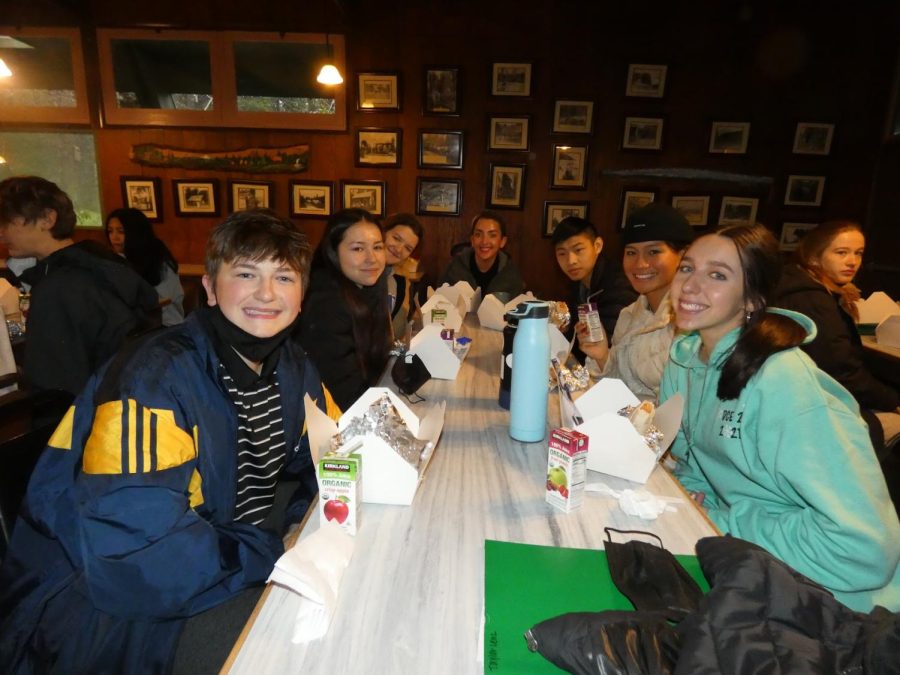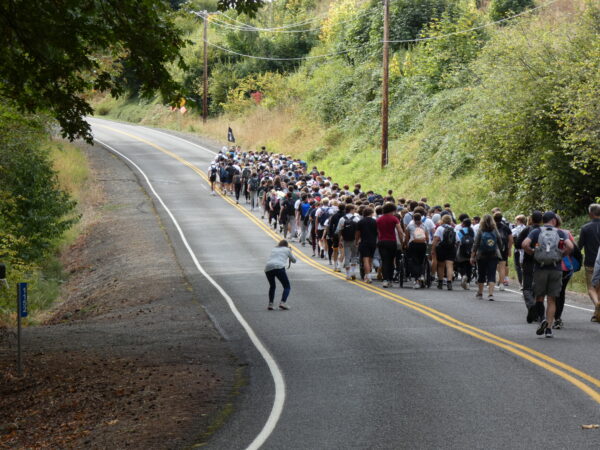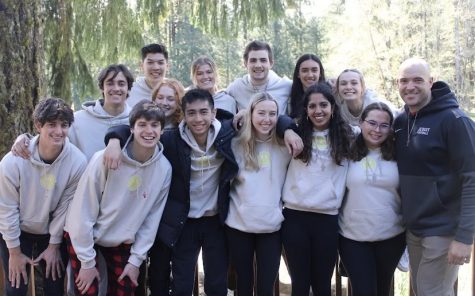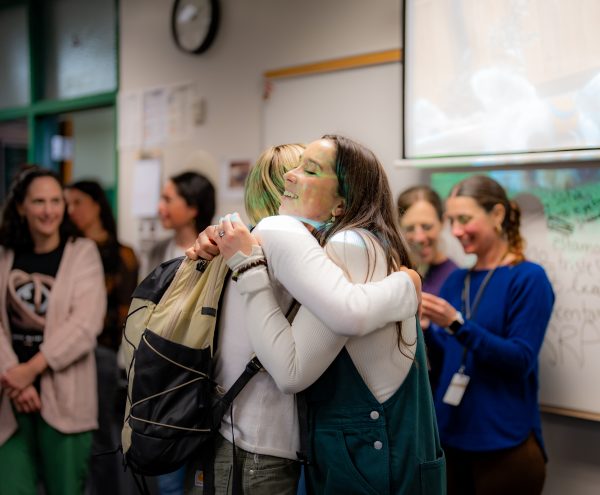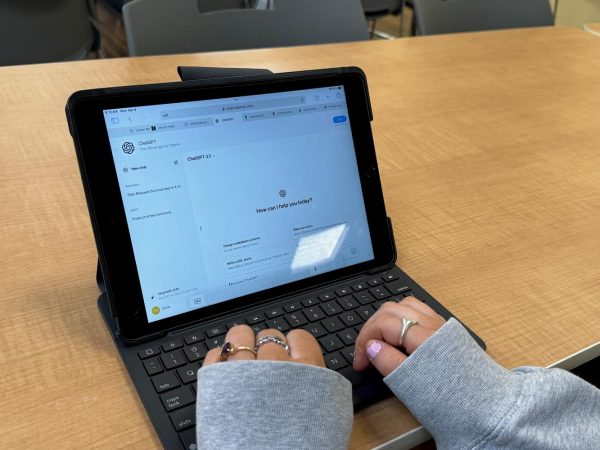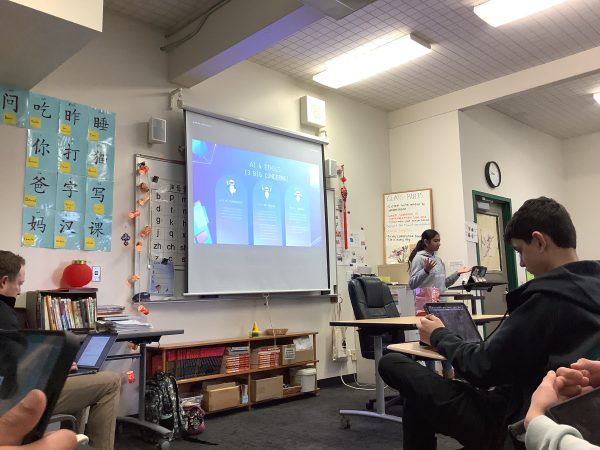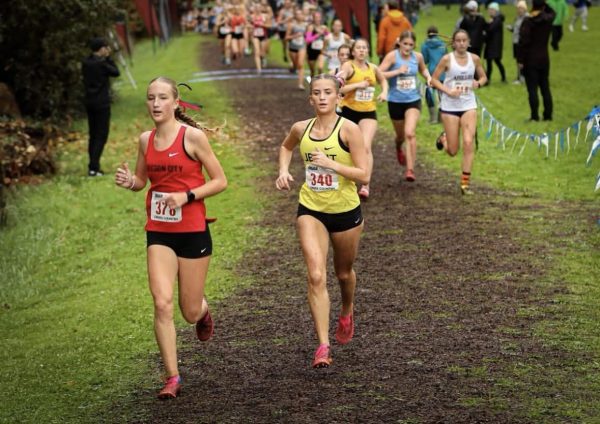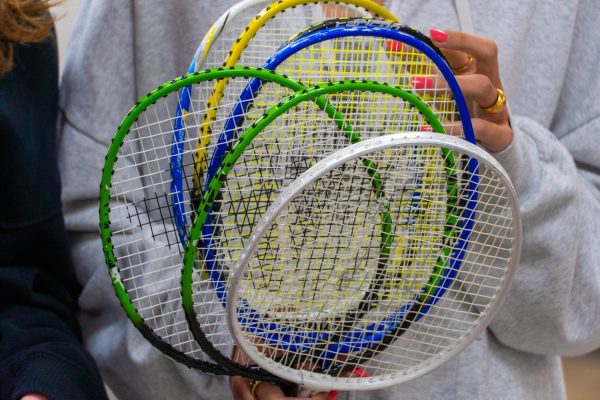More Inclusive Encounter Menu Strengthens Community
Students eat lunch at St. Benedict’s lodge while on a December Coed Encounter.
In front of a roaring fire in the St. Benedict’s lodge, students gather with paper plates balanced on laps, sharing a meal together. Alongside the warmth and noise that permeates the rooms, a palpable sense of community also hangs in the air. Jesuit’s encounter retreat is built on community and love. For many individuals, food is an expression of this love, an opportunity to build community together.
For some individuals with dietary restrictions, their sense of community was slightly hindered by their experience with their food which left them feeling unsatisfied and unwell. On the encounter, individuals with dietary restrictions—vegetarian, vegan, gluten and dairy free—usually receive alternative meals as most of the main menu items have meat and dairy as staple ingredients. Oftentimes, these substitute meals are frozen or boxed in order to make it convenient for the few volunteer cooks tasked with the difficult feat of feeding a large group of hungry teenagers.
“The cooks are all volunteers, mostly parents and alumni,” said Al Kato, a member of the campus ministry team who oversees food on encounters. “The meal has to be something that is easy and simple to make. It also has to be able to hold for a while as sometimes the encounter does not run exactly on schedule. So, it has to be able to be cooked and then put in a warming oven and still be ok.”
An even larger challenge: making dietary restriction-friendly meals in advance and keeping them warm. .
“One thing I noticed was it was really difficult for the people cooking the meals to time the alternative meals with the regular ones,” English teacher and leader on encounters Megan Mathes said. “Since a lot of the meals were frozen, it seemed as though a lot of them were being made in advance and were put in a warming oven, so the food would dry out and become dehydrated.”
While frozen meals are convenient for the encounter’s limited cooking staff, they also made some students feel ill or left them hungry.
“I never really felt full or nourished with whole, healthy food,” said senior Claire Cooney, who went on an encounter in December and received the vegetarian substitute meals.
“The food was mostly processed, which left me feeling unsatisfied,” Cooney said.
Senior Eiley Eichten had similar complaints with her vegan substitution food.
“Most of the frozen and processed foods have a ton of sodium in them,” Eichten said. “This sodium, especially because I do not typically eat a ton of sodium, was what was causing a lot of my upset stomachs. It would be nice to see some more fresher, homemade meals.”
Understanding that the food options for a vegan were limited, Eichten ended up bringing a lot of her own food to eat during breaks.
Senior Medini Madhusudan, a November Coed Encounter leader, also felt sick after eating the vegetarian meals.
“Every meal that I ate had some type of soy product in it,” Madhusudan said. “I don’t typically get all protein strictly from soy, so I was not used to eating that much soy in a short period of time. On the second to last day [of the encounter], I got heartburn which lasted for three days after the encounter.”
While Madhusudan said that most of her encounter experience remained highly positive and untainted from her experience of the food, her heartburn did prove to be a slight distraction, especially towards the end.
“During the last small group, some of my focus was definitely on the discomfort of the heartburn,” Madhusudan said.
Madhusudan remembers one meal in particular that was lacking: a substitution for the usual meal of hamburgers that consisted of a sandwich with only lettuce, mayo, cheese, and tomatoes.
“An alternative to a meal hamburger should be a black bean or falafel patty,” Madhusudan said. “There were a lot of possible alternatives that would have made the substitution healthier and more filling.”
Madhusudan wonders if part of this problem stems from a lack of understanding and familiarity with vegetarian food among the volunteer cooks. While it is understandable that the volunteers may not have extensive cooking experience, it can cause some limitations in the palatability of the substitution meals, a limitation that can be remedied with more awareness around vegetarian eating.
“If more cooks were familiar with vegetarian, gluten-free, and dairy-free cooking and were aware of other substitutions, not just soy, that would work a lot better,” Madhusudan said.
Hearing these complaints from students while on an encounter, Mathes was inspired to expand the menu to be more inclusive of individuals with dietary restrictions and provide them with healthy and fresh alternatives by eliminating the use of frozen and premade meals.
“Watching students get their meals while on the December encounter, I was really upset and could tell that they were upset as well,” Mathes said. “As a home cook, I knew that we could very easily do something better that didn’t require processed food.”
Before creating a new menu, Mathes had to stay cognizant of the encounter’s guidelines and restrictions. One key aspect is simplicity. Convenience was one of the driving reasons the dietary restriction menu relied on frozen, premade meals in the first place. Part of creating convenience involved coming up with alternatives that were as close to the original menu items as possible and required the least amount of varying ingredients.
“It’s a lot more spendy when you have to buy different ingredients for different dietary restriction-friendly meals,” Kato said. “It’s our intention to serve the same meal to everyone as much as possible, even if they have alterations.”
In order to honor this goal, Mathes’ process for refreshing the menu started with finding healthy and easy substitutions adjacent to the meals already being served.
“The process was easy, it was just looking at the menu item, such as a lasagna, and trying to find a vegetarian, gluten, and dairy-free substitution for that,” Mathes said.
Not only did Mathes try to find a substitution that was close to the original menu item, she also tried to find substitutions that were easy to make in large quantities with limited resources.
“I also had to be mindful that I and one other person were going to be cooking these meals for the entire encounter, so I had to be able to make these meals quickly and do prep in advance,” Mathes said.
In addition to being able to create new items for individuals with dietary restrictions, this menu offered new opportunities for students without dietary restrictions too as the first day of the first April encounter fell on a Lenten Friday, when Catholics refrain from eating meat.
As a result, Mathes decided to serve a vegetarian chili to all individuals on the encounter, in replace of the usual lunch of hamburgers. To Mathes’s delight, the vegetarian chili was a huge success with vegetarians and meat eaters alike.
“It was really exciting to see people coming back for seconds,” Mathes said. “We had quite a bit of leftovers and people were asking for more during dinner that night and lunch the next day.”
In addition to allowing students to expand their food preferences, serving the vegetarian chili also allowed students to feel community in an even deeper way. Students were not only eating together, but eating the same meal as well, no matter their dietary differences.
“There’s something really lovely about seeing everyone being together and eating together,” Mathes said. “To be able to serve food that everyone wanted to eat and could eat together is part of that relationship between community, eating and fellowship.”
Mathes elaborates on how this fellowship can be disrupted without proper options for students with dietary restrictions.
“I think every student on the encounter should feel loved, valued, and respected and food is a part of that,” Mathes said. “If you are handed a plate of something that is not appetizing or healthy, it might hurt a little.”
While providing healthy and tasty food is one way to ensure that students feel respected, it can also help to mitigate guilt or shame of students with dietary restrictions, some of whom feel like a burden.
“Previous years, especially as a freshman, I did not want to cause any trouble for anyone, so on retreats, I did not say that I was vegetarian,” Madhusudan said. “I ended up not having a lot of food options I could eat, but I didn’t want to say anything and didn’t know how.”
In addition to feeling a sense of shame, having dietary restrictions can also be a source of isolation for some students. Normally, students with dietary restrictions would go back to the kitchen to receive their meals while the rest of students got their meals from bistro tables in the dining room, causing a possible sense of division.
“When you have a dietary restriction and you have to go back into the kitchen to get your food, there’s this sense that you’re set apart,” Mathes said.
Eichten has experienced some sense of this isolation.
“As a vegan among others who have more regular diets, I do feel like I stick out like a sore thumb,” Eichten said.
Mathes saw this separation as another practice in need of reform and decided to serve her vegetarian, dairy-free, and gluten-free alternative meals on the same table as the regular meals, in order to normalize receiving food alternatives and dispel conceptions of divisions.
“One of the reasons that we put the dietary restriction menu on the line was so that students didn’t have to go back into the kitchen to get their food, it was right there,” Mathes said.
In addition to fulfilling Mathes’ goal to provide students with dietary restrictions with healthier and tastier alternatives, the new menu items had an added benefit: individuals were introduced to vegetarian eating and many learned that they enjoyed it.
“People are never going to understand that they can enjoy vegetarian food until they try it,” Mathes said. “It’s not something they have to eat all the time, but I hope it is a positive experience we can provide for students.”
Mathes explains that introducing students to vegetarian meals and pushing back against the misconception that meals must have meat in order to be healthy or satisfying is especially important as we learn more about the ways eating more plant-based meals can mitigate individuals’ carbon footprint.
“We all know that for the good of the planet we should be eating less meat,” Mathes said. “But, I think a lot of people can’t imagine their lives without meat. If we can help start the process by making appetizing meals without meat, some people might realize that they can go a few meals or a few days without eating meat and eventually make those life-style changes over time.”
Working to limit the carbon footprint of retreats, the campus ministry team recently decided that encounters would now be beef-free.
“We know that beef is a harmful meat to the environment, so we wanted to see if we could drop it or reduce its consumption,” said Don Clarke, the head of campus ministry. “We wanted to look at how we can help our planet and how we can make a statement.”
In addition to making the encounter menu beef-free, the campus ministry department also decided to add Mathes’s chili to the menu, adding an option with turkey meat alongside the vegetarian chili.
Aside from these changes, the menu for vegetarians, vegans, and other individuals with dietary restrictions still varies widely from encounter to encounter. The choice to make separate meals for individuals with dietary restrictions will rest with the volunteer cooks.
“From here on, it depends on the cooks,” Kato said. “If the cooks want to cook a different meal for the vegetarians they can, but if not I will have to buy a premade frozen meal for those kids.”
While the decision is ultimately left to the cooks, it is still Clarke’s priority to limit the amount of processed foods as much as possible.
“We try not to use processed foods, unless there are specific dietary restrictions that we cannot accommodate,” Clarke said.
With Covid restrictions easing, the amount of cooks working on the encounter has doubled from 4 to 8, making it easier for the cooks to make additional meals for individuals with dietary restrictions.
The main reason the menu for students with dietary restrictions is not standardized is because the number of students with dietary restrictions varies very heavily from encounter to encounter.
“We had a few encounters this year where none of the students attending had dietary restrictions, which made it a lot easier for the cooks,” Clarke said. “Other times, there would be 10-11 students [with dietary restrictions], about a quarter of the people attending.”
Not only do the number of students with dietary restrictions vary between encounters, the skill set and repertoire of the cooks also varies, again making it difficult to standardize the menu.
“Each cook brings in their own style and talents,” Clarke said. “There are some cooks who are really good at cooking meals for students with dietary restrictions.”
Madhusudan says remedying negative experiences with the encounter food could come not from standardizing the dietary restriction menu and ensuring that cooks try to make several different meals for each dietary restriction, but by making more meals that are vegetarian or vegan based and work for everyone.
“One thing that could help is serving more meals that are not necessarily focused around meat,” Madhusudan said. “They then could serve meat on the side for the individuals who want it. It seems that more people have dietary restrictions than in past years, so they will have to change the menu to reflect that.”




